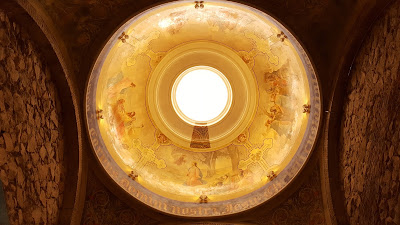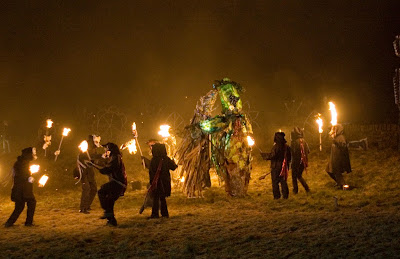Basilica of Saints Justus and Pastor - Returning to a Secret Treasure
Written by MikeH
My personal experience with the Basilica of Saints Justus and Pastor has been so fascinating that I decided to go back and take the official tour in an attempt to delve into the history of this temple. In my first post I referred to the church as the “hidden treasure in the heart of Barcelona” and as I write down these lines, I can affirm without doubt that this magnificent building really deserves the title.
During my return visit I had the opportunity to explore the remains of the Episcopal Complex which comprises of some Roman structures dating from the 1st century; a Baptismal Font from the 6th century; the Holy Sacrament Chapel and with its colorful dome; the magnificent Bell Tower which offers an outstanding view of the city. All these archaeological discoveries reinforce what tradition has said for so many years: the Basilica of Saints Justus and Pastor is one of the oldest Christian sanctuaries in the city.
Summarizing two thousand years of history and the legends around this temple would be, once again, an extremely difficult task. There are other architectural structures to be seen and explored, which deserve certainly more than just one blog post. Being passionate about ancient history, I have decided for this post to leave aside all the conspiracy theories and myths and to focus on the historical aspects of this extraordinary monument. Please accompany me on a journey back in time where I will take you to the recently opened areas within the Basilica of Saints Justus and Pastor.
The Holy Sacrament and the New Martyrs Chapel
Let us begin the tour inside the current basilica, at the Holy Sacrament and the New Martyrs Chapel. Built in 1705, it can be accessed through a wrought iron gate from the same period and framed with glass decoration with representations of images used in the ecclesiastical sacraments: wheat, wine and oil. The Chapel’s Dome is perhaps the structure which grabs the attention immediately. Decorated with representations of the Passion and the Resurrection of Jesus Christ, these paintings from the 19th century were discovered by accident under a thick layer of grey paint!
 |
| Chapel Dome |
The Sacristy
Moving forward with the tour, inside the Sacristy, it is possible to view the remains of the Baptismal Font dating from the 6th century, which was probably cross-shaped and whose dimensions are similar to the one found in the Cathedral. This reinforces the theory that the Basilica of Saints Justus and Pastor acted as a secondary cathedral. In fact, the temple would have been the See of the Catholic Bishop of Barcelona during the Visigoth occupation. The co-existence of two baptismal fonts in the same city is very unusual during the late Roman period (the only archaeological evidences of these cases correspond to Ravenna, in Italy, and Barcelona), as the baptisms would be carried out solely by the Bishop during Easter and within the “Cathedral”.
The digs in the basement of the sacristy brought to light another exceptional discovery. A Common Grave was also found which contained approximately 120 skeletons of people who, according to carbon dating and additional tests, died during the Black Death in the 14th century. There are several written sources describing this terrible period in Europe, but the archaeological sources are scarce. Aside from this recent discovery in Barcelona, the other remains of these massive burials can be found solely in London or East Smithfield (UK), Prague (Czech Republic) or in Marseille, Martigues or Potiers (France).
Inside the Basilica
Inside the Basilica
Remaining inside the current basilica, it is possible to see the remains of the Apsidal Wall of the church from the 6th century through a glass opening on the floor. On the lower level can be found a Crypt ('confessio') of a Prominent Christian from that period of time, in addition to a small window ('fenestella confessionis') which would allow the faithful to look inside the underground crypt and pray.
The central part of the apse, where the altar once stood, is framed by the Triumphal Arch, resting on two large columns. This discovery allowed the experts to reconstruct the ground plan of the ancient Christian temple that most probably was placed transversely to the present Gothic church. Other remains from the Visigoth period are the two Capitals placed in different sections of the basilica. These were reused later as Holy Water Stopes.
 |
| Prominent Christian Crypt - 6th Century |
The Bell Tower
Nearly at the end of the tour, after climbing several steps on a narrow spiral staircase, the Bell Tower offers an impressive panoramic view of the city. At this viewpoint it is possible to admire Barcelona from north to south, from the sea to the mountains. This spot offers amazing perspectives of the Cathedral, the Town Council, the Generalitat Palace, the City Port and Montjuic; ideal for lovers of photography.
The bell tower is around 35 meters high and its base was built in the 16th century. The tower is topped by a handrail placed in 1572 and on the lateral side can be found two sculptures representing the Saints, Justus and Pastor, the Christian martyrs who lived in the time of the Emperor Diocletian. The four bells with the names of Egidia, Pastora, Justa and Montserrada, manufactured between the 17th and 18th centuries, were taken to the city of Palencia in order to be restored.
 |
| City View from Bell Tower |
The recent archaeological discoveries highlight the historical richness and the uniqueness of this hidden treasure in the heart of our city - the Basilica of Justus and Pastor. I am simply amazed about how much I learned about the history of this magnificent temple and of the city. Dear readers, once again, whether you are a lover of history or of photography or simply curious, I encourage you to get lost in the Gothic Quarter and explore this magnificent temple for yourselves.
Images: Supplied by Author.


Comments
Post a Comment